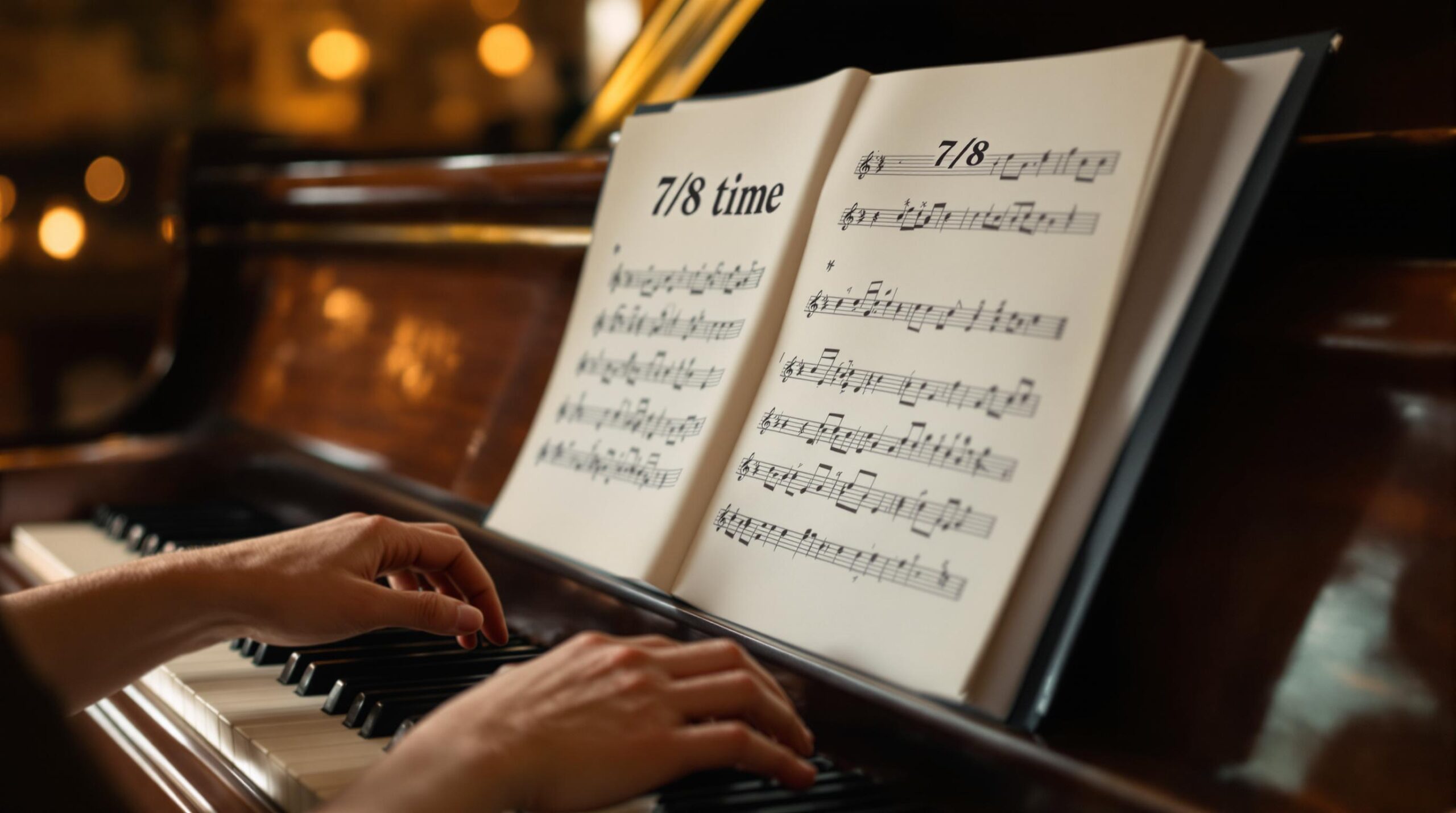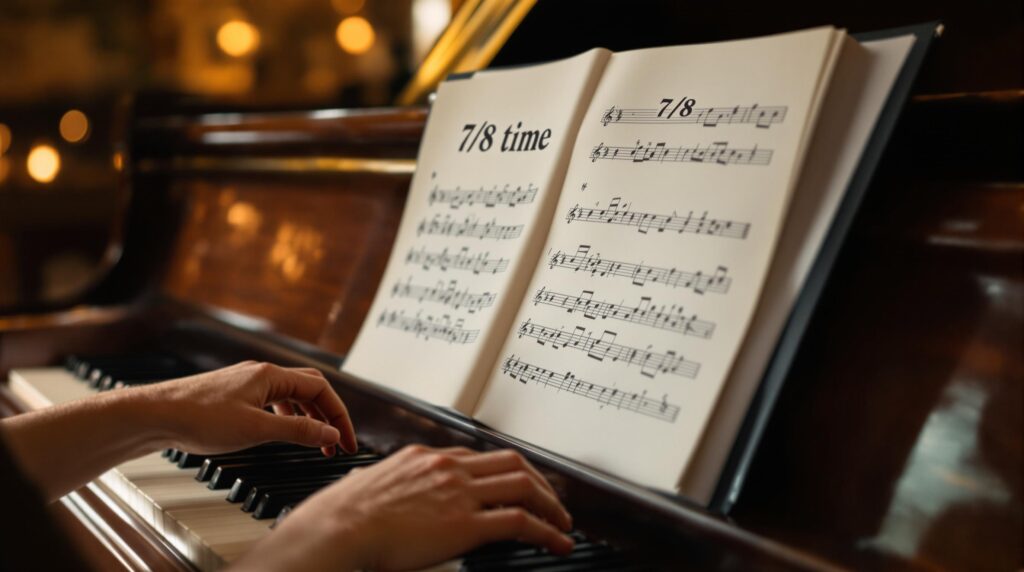
Want to master 7/8 time on the piano? Start by understanding its unique rhythm: 7 eighth notes per measure, typically grouped as 2+2+3, 3+2+2, or 2+3+2. This uneven structure creates an energetic, offbeat feel, found in genres like progressive rock, jazz fusion, and Balkan folk music.
Key Points:
- Counting 7/8: Break it into groups (e.g., "ONE-two, ONE-two, ONE-two-three").
- Practice Tips: Clap, tap, or step to emphasize strong beats.
- Playing Basics: Start slow, play one note per beat, and gradually add left-hand bass notes.
- Advanced Skills: Transition between time signatures and explore complex rhythms.
Quick Comparison of Beat Patterns:
| Pattern | Grouping | Accent | Common Usage |
|---|---|---|---|
| Forward | 2+2+3 | ONE-two, ONE-two, ONE-two-three | Jazz, modern classical |
| Backward | 3+2+2 | ONE-two-three, ONE-two, ONE-two | Balkan folk, prog rock |
| Mixed | 2+3+2 | ONE-two, ONE-two-three, ONE-two | Contemporary fusion |
Whether you’re just starting or looking to refine your skills, steady practice and a metronome can help you master this rhythm. Ready to dive in? Let’s break it down step by step.
Reading 7/8 Rhythm
7/8 Beat Patterns
To get comfortable with 7/8 rhythm, start by understanding its beat patterns:
| Pattern | Grouping | Accent | Common Usage |
|---|---|---|---|
| Forward | 2+2+3 | ONE-two, ONE-two, ONE-two-three | Modern classical, jazz |
| Backward | 3+2+2 | ONE-two-three, ONE-two, ONE-two | Balkan folk, prog rock |
| Mixed | 2+3+2 | ONE-two, ONE-two-three, ONE-two | Contemporary fusion |
Each pattern shifts the accent and feel, creating unique rhythmic textures. Focus on emphasizing the first note of each group to capture the rhythm’s essence.
How to Count 7/8
Counting accurately is key to mastering 7/8 rhythm. Match your syllables to the beat groupings for better precision:
For the 2+2+3 pattern:
- Count: "ONE-two, ONE-two, ONE-two-three"
- Or try: "short-short, short-short, long-and-a"
For the 3+2+2 pattern:
- Count: "ONE-two-three, ONE-two, ONE-two"
- Or try: "long-and-a, short-short, short-short"
Start practicing at 60 BPM, focusing on tapping only the strong beats. Once you’re comfortable, gradually increase the tempo.
Basic Rhythm Practice
Use these patterns and counting methods to build a steady rhythm:
- Clap on the strong beats while counting aloud.
- Step on the strong beats and tap the weak beats with your hands.
- Use your right hand to tap strong beats and your left hand for weak beats.
To improve further, add dynamics:
- Emphasize the first beat of each group.
- Practice transitioning smoothly between different 7/8 patterns.
- Combine clapping and counting at the same time.
Begin by practicing these exercises away from your instrument to focus solely on rhythm. Once you feel confident, integrate them into your piano practice for a more cohesive learning experience.
How to play piano in 7/8 the easy way!
sbb-itb-b8bc1ab
Playing Piano in 7/8
Take your 7/8 rhythm skills to the piano by applying your counting methods to key patterns. Using the 2+2+3 pattern, transfer these techniques directly to your playing.
Right Hand Basics
Begin by playing one note per beat, following the 2+2+3 structure:
| Beat Group | Notes to Play | Counting |
|---|---|---|
| First 2 | C – D | ONE-two |
| Second 2 | E – F | ONE-two |
| Final 3 | G – A – B | ONE-two-three |
Start slow at 60 BPM, focusing on even pressure and smooth transitions between notes.
Adding Left Hand Parts
Introduce left-hand bass notes on the strong beats:
- Play C on beat 1, F on beat 3, and G on beat 5 with your left hand.
- Keep the right hand playing the melodic pattern above.
- Hold each bass note for the full duration of its group.
Once comfortable, add simple chord voicings using root position triads to enrich the sound. Combine both hands carefully, ensuring the timing stays tight.
Keeping Steady Time
Bringing both hands together requires consistent timing. Try these tips:
- Use Physical Cues: Nod your head on strong beats or tap your foot to follow the eighth-note pulse.
- Practice with a Metronome: Set it to 50-60 BPM to highlight the 2+2+3 accents and practice until your timing feels solid.
- Record and Review: Record your sessions and listen back to spot timing errors. Pay attention to:
- Evenness of eighth notes
- Emphasis on strong beats
- Smooth transitions between beat groups
- Balance between the left and right hands
Advanced 7/8 Techniques
Reading 7/8 Sheet Music
When reading 7/8 sheet music, keep an eye on these key aspects:
- Bar Lines: Each measure includes exactly 7 eighth notes.
- Beaming: Notes are often grouped as 2+2+3 or 3+2+2.
- Dynamic Markings: Look out for accent marks (>) that indicate the grouping pattern.
Before playing, identify the grouping pattern and scan ahead for any rhythm or accent changes. A helpful tip: tap out the rhythm first to get comfortable with the flow.
Changing Time Signatures
Switching between 7/8 and other meters requires a steady pulse. Here’s how to handle it:
- Keep the eighth note duration consistent when moving between meters.
- Highlight the downbeat of each new measure to establish the meter.
- Focus on practicing the specific measures where transitions occur.
Here are some common transitions and how to approach them:
| From Time Signature | To Time Signature | Practice Tip |
|---|---|---|
| 7/8 | 4/4 | Add 1 eighth note. |
| 7/8 | 3/4 | Subtract 1 eighth note. |
| 7/8 | 6/8 | Adjust by adding or subtracting eighth notes. |
Once you’re comfortable with these transitions, explore pieces that use them to further refine your timing and rhythm.
7/8 Piano Pieces by Level
Beginner Level
Start with simple pieces that focus on right-hand melodies and single-note patterns. Left-hand work should stick to basic chord progressions.
Intermediate Level
Move on to syncopated rhythms, more intricate left-hand patterns, and experimenting with tempo changes.
Advanced Level
Challenge yourself with polyrhythms, frequent time signature changes, and complex harmonic progressions.
When starting new pieces, keep the tempo at 60 BPM. Only increase speed once you can maintain steady rhythm and coordination.
Next Steps
Main Points Review
To master 7/8 time, focus on consistent and dedicated practice. Here are the key areas to concentrate on:
- Steady Pulse: Maintain a solid eighth-note rhythm throughout.
- Grouping Patterns: Work on common rhythmic divisions to feel the meter naturally.
- Hand Independence: Gradually build coordination between your hands.
- Transitions: Practice moving smoothly between different meters.
- Dynamic Control: Use accents effectively to emphasize groupings.
Check out our structured lesson plans below for more detailed guidance.
Learning Resources
Enhance your 7/8 time skills with specialized piano lessons. Cooper Piano offers tailored instruction to match your skill level, led by experienced instructors who can help you with:
- Proper techniques for counting complex time signatures.
- Exercises to improve hand coordination.
- Interpreting sheet music with precision.
- Training for advanced rhythmic patterns.
In-person lessons are available at Cooper Piano’s Atlanta location during the following hours:
Mon–Sat: 10:00 AM–6:00 PM
Sun: 1:00 PM–5:00 PM
For personalized help mastering 7/8 time or other advanced techniques, call 404-329-1663.

